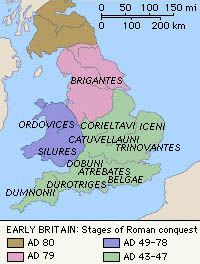
Ancient Britain
Roman Britain
 Julius Caesar invaded Britain in 55 BCE and returned the following year to defeat the native forces. The inhabitants, referred to collectively as Britons, maintained political freedom and paid tribute to Rome for almost a century before the Roman emperor Claudius I initiated the systematic conquest of Britain in CE 43. By 47, Roman legions had occupied all the island south of the Humber River and east of the Severn River. Julius Caesar invaded Britain in 55 BCE and returned the following year to defeat the native forces. The inhabitants, referred to collectively as Britons, maintained political freedom and paid tribute to Rome for almost a century before the Roman emperor Claudius I initiated the systematic conquest of Britain in CE 43. By 47, Roman legions had occupied all the island south of the Humber River and east of the Severn River.
The tribes, notably the Silures, inhabitants of what are now the Wales and Yorkshire regions, resisted stubbornly for more than 30 years, a period that was marked by the abortive and bloody rebellion in 61 led by the native queen Boudicca. At this time Britain became an imperial province of Rome, called Britannia, administered by Roman governors. About 79, Roman legions subdued the tribes in Wales and established partial control over those in Yorkshire. Between 79 and 85, Roman forces commanded by Gnaeus Julius Agricola moved through the northern section of the island, completing their conquest to the Firth of Forth. Agricola also pushed northward into Caledonia (now called Scotland), but the region between the firths of Forth and Clyde remained disputed territory. The Caledonian tribes, the Picts, retained their independence.
Little is known of the relations between the Britons and their conquerors between 85 and 115. Shortly after 115, the natives rose in revolt against their overlords and annihilated the Roman garrison at Eboracum (now York). As a result, the Roman emperor Hadrian visited Britain in 122 and began the construction of a rampart 117 km (73 mile) long, reaching from Solway Firth, on the Irish Sea, to the mouth of the Tyne River. Fragments of this wall, called Hadrian's wall, still stand. Twenty years later, another wall, called the Antonine Wall, was built across the narrowest part of the island, from the Firth of Forth to the Firth of Clyde. The region between the two walls was a defense area against the Caledonians, who were eventually driven north of Hadrian's Wall in the 3rd century. The wall marked the northern Roman frontier during the next 200 years, a period of relative peace.
During the period of conquest and military campaigns, Britain was a military stronghold of the Roman army, but the people of Britain benefited from Roman technology and cultural influences. The native tribes became familiar with many features of Roman civilization, including its legal and political systems, architecture, and engineering. Numerous towns were established, and these strongholds were linked by a vast network of military highways, many remnants of which survive. Archaeological evidence from the occupation period indicates that the Romans brought their entire culture to Britain. In general, however, only the native nobility, the wealthier classes, and the town residents accepted the Roman language and way of life, while the Britons in outlying regions retained their native culture.
At the end of the 3rd century, the Roman army began to withdraw from Britain to defend other parts of the Roman Empire. In 410, when the Visigoths invaded Rome, the last of the Roman legions were withdrawn from the island. Celtic culture again became predominant, and Roman civilization in Britain rapidly disintegrated. Roman influence virtually disappeared during the Germanic invasions in the 5th and 6th centuries. Thereafter the culture of the Angles and Saxons spread throughout the island. Historians refer to Britain after the Germanic invasions as England, Scotland, and Wales.
Index
|











